
Itsukushima Shrine is a Shinto shrine on the island of Itsukushima, best known for its "floating" torii gate. It is in the city of Hatsukaichi in Hiroshima Prefecture in Japan. The shrine complex is listed as a UNESCO World Heritage Site, and the Japanese government has designated several buildings and possessions as National Treasures.

Munakata Taisha (宗像大社) is a collection of three Shinto shrines located in Munakata, Fukuoka Prefecture, Japan. It is the head of the approximately 6,000 Munakata shrines all over the country. Although the name Munakata Taisha refers to all three shrines—Hetsu-gū, Nakatsu-gū and Okitsu-gū—it is commonly used to refer to Hetsu-gū alone. As documented in Japan's second oldest book, Nihon Shoki, the shrines are devoted to the three Munakata goddesses.

Shizuoka Sengen Jinja (静岡浅間神社) is the name for a collective group of three Shinto shrines now forming a single religious corporation, located at Mount Shizuhata in Aoi-ku, Shizuoka, in Shizuoka Prefecture, Japan. These shrines are the Kanbe Jinja (神部神社), Sengen Jinja (浅間神社), and Ōtoshimioya Jinja (大歳御祖神社). The main festival of the shrine is held annually on April 5.

Futarasan jinja (二荒山神社) is a Shinto shrine in the city of Nikkō, Tochigi Prefecture, Japan. It is also known as Nikkō Futarasan Shrine, to distinguish it from the shrine in nearby Utsunomiya. Futarasan enshrines three deities: Ōkuninushi, Tagorihime, and Ajisukitakahikone. It is located between Nikkō Tōshō-gū and the Taiyū-in Mausoleum. Many visitors go to all three, as well as to Rinnō-ji.

The Hie Shrine is a Shinto shrine in Nagatachō, Chiyoda, Tokyo, Japan. Its June 15 Sannō Matsuri is one of the three great Japanese festivals of Edo. Other names for the shrine include Hiyoshi Sannō-sha, Hiyoshi Sannō Daigongen-sha, Edo Sannō Daigongen, Kōjimachi Sannō, Sannō-sha, and Sannō-sama.

Hiyoshi Taisha (日吉大社) is a Shinto shrine located in the city of Ōtsu, Shiga Prefecture Japan. This shrine is one of the Twenty-Two Shrines. Known before World War II as Hiei Taisha (日枝大社) or Hie jinja, "Hiyoshi" is now the preferred spelling. It was also known as the Sannō Gongen (山王権現). The head shrine in Ōtsu heads the seventh largest shrine network in Japan, with approximately 3800 Hiyoshi, Hie, and Sannō shrines nationwide. Torii of this shrine have a distinctive configuration, known as the "Sannō torii", with a gaggle above the main crossbeam. The 400,000 square meter precincts centered is designated as a National Historic Site, and the east and west main shrine buildings, the Nishi Hongū (西本宮) and Higashi Hongū (東本宮) are designated as National Treasures, and many of the structures in the precincts are designated as National Important Cultural Properties.
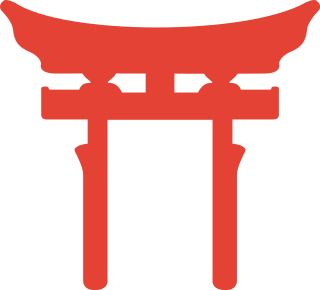
The Association of Shinto Shrines is a religious administrative organisation that oversees about 80,000 Shinto shrines in Japan. These shrines take the Ise Grand Shrine as the foundation of their belief.
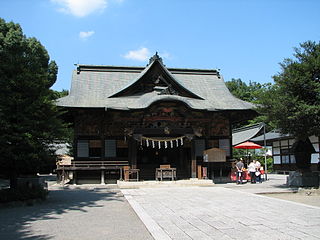
The Chichibu Shrine is a Japanese Shinto shrine at Chichibu in Saitama Prefecture.

Chikubu is a small island in the northern part of Lake Biwa in Shiga Prefecture, in the Kansai region of Japan. It has been known since ancient times for the beauty of its scenery and for its small Shinto shrine and Buddhist temples. Administratively, the island is part of the city of Nagahama, Shiga|Nagahama]]. The island is both a nationally designated Place of Scenic Beauty and Historic Site.
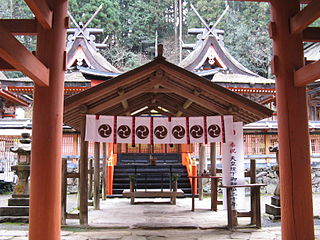
Niutsuhime Shrine or Nibutsuhime Shrine is a Shinto shrine in Ito district, Wakayama Prefecture, Japan. The main hall is partially built in the kasuga-zukuri style.

The Hakone Shrine is a Japanese Shinto shrine on the shores of Lake Ashi in the town of Hakone in the Ashigarashimo District of Kanagawa Prefecture. It is also known as the Hakone Gongen (箱根権現).

Kono Shrine is a Shinto shrine in Miyazu, Kyoto Prefecture, Japan. The upper sanctuary where Manai-jinja of the Shrine is considered the original place where Toyouke-Ōmikami was enshrined before the age of Emperor Yūryaku.

Toga Shrine is a Shinto shrine in the city of Toyokawa in eastern Aichi Prefecture, Japan. It is the ichinomiya of former Mikawa Province. Located on the borderland of Aichi with Shizuoka Prefecture, the summit of Mount Hongū 782 metres (2,566 ft) is a sacred mountain considered to be within the precincts of the shrine, and has a subsidiary chapel.
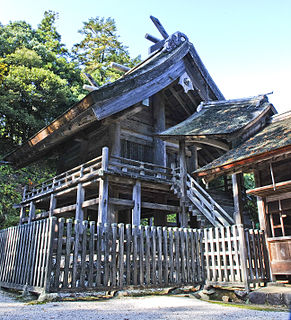
Kamosu Jinja (神魂神社) is a Shinto shrine in Matsue, Shimane Prefecture, Japan. The Taisha-zukuri Honden of 1583 is a National Treasure. The coeval branch Inari shrine is an Important Cultural Property.

Mikami Shrine) is a Shinto shrine located in the city of Yasu, Shiga Prefecture, Japan. The kami worshipped at this shrine is Ame-no-mikage-no-mikoto, Amaterasu's grandson, who in legend, descended onto 432-meter Mount Mikami during the reign of Emperor Kōrei to become the shintai of the mountain.

Ōsasahara Shrine) is a Shinto shrine located in the city of Yasu, Shiga Prefecture, Japan. The kami worshipped at this shrine are Susanoo-no-Mikoto and Kushinadahime.
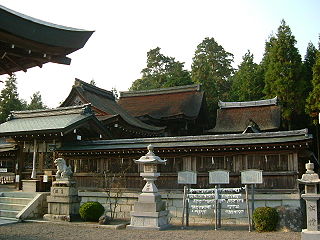
Namura Shrine (苗村神社) is a Shinto shrine located in the town of Ryūō, Shiga Prefecture, Japan. The shrine has many structures from the Muromachi period or older which are designated either National Treasures (NT) or Important Cultural Properties (ICP). Although the shrine holds annual festivals, the shrine's main festival is held only once every 33 years.
Sakurai Shrine is a Shinto shrine located in Sakai, Osaka Prefecture, Japan. It was founded at an unknown date and holds its annual festival on the first Sunday in October. It enshrines Emperor Ōjin, Emperor Chūai, and Empress Jingū as kami. The oratory is designated as the only Japanese National Treasure in Sakai City.
Kandani Shrine is a Shinto shrine located in Sakaide, Kagawa Prefecture, Japan. It enshrines the kami Kagu-tsuchi (火結命), Okitsuhiko no mikoto (奥津彦命), and Okitsuhime no mikoto (奥津姫命). According to legend, the shrine was established in 812. The shrine's main hall is designated as a Japanese National Treasure.


















